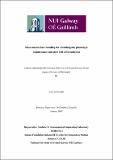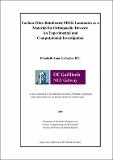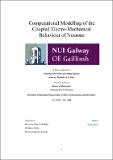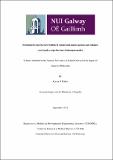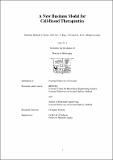Search
Now showing items 1-10 of 22
The role of matrix properties and extrinsic loading in osteoblast-osteocyte differentiation in tissue engineered scaffolds
(2018-02-05)
Bone tissue engineering is a promising field with the potential to generate tissue substitutes, by taking advantage of mesenchymal stem cells ability to grow and produce tissue substitutes under specific physical conditions. ...
The influence of collagen isolation, cross-linking and sterilisation on macrophage response
(2018-03-07)
Collagen-based devices are frequently associated with foreign body response. Although several pre- (e.g. species, state of animal, tissue, isolation protocol) and post- (e.g. cross-linking, scaffold architecture, sterilisation) ...
Macromolecular crowding for chondrogenic phenotype maintenance and stem cell differentiation
(NUI Galway, 2019-01-31)
Chondrocyte-based tissue engineering therapies require in vitro cell expansion, which is associated with loss of phenotype, decrease in synthesis of collagen type II and increase in synthesis of collagen type I. Another ...
Carbon fibre reinforced PEEK laminated as a material for orthopaedic devices: An experimental and computational investigation
(NUI Galway, 2018-11-27)
The overall objective of this thesis is to investigate carbon fibre reinforced poly-ether-ether-ketone (PEEK) laminates as a material for fracture fixation devices through a combination of experimental testing and computational ...
A thermodynamically motivated investigation of cell and tissue remodelling
(NUI Galway, 2018-08-24)
The overall objective of this thesis is to provide a new understanding of the mechanisms that drive cell spreading and remodelling, and to extend this understanding to remodelling at a tissue and organ level.
A steady-state ...
Elastin-like recombinamers-based hydrogel modulates the post-ischemic remodelling in a clinically-relevant model of myocardial infarction
(NUI Galway, 2019-04-17)
Myocardial infarction (MI) belongs to the family of cardiovascular diseases and represents the primary cause of worldwide mortality. Despite the promising results achieved in both small and large animal studies, recent ...
Computational modelling of the coupled electro-mechanical behaviour of neurons
(NUI Galway, 2019-01-22)
Recent experimental evidence has uncovered complex biophysical phenomena accompanying the electrical activity of nervous cells. Now emerging theories refer to the electric pulse, i.e. the Action Potential (AP), as an ...
Development and characterisation of compressed, macro-porous and collagen-coated poly-ε-caprolactone electrospun meshes
(NUI Galway, 2019-02-25)
Electrospun scaffolds are utilised in a diverse spectrum of clinical targets, with an ever-increasing quantity of work progressing to clinical studies and commercialisation. However, the very dense architecture and the low ...
A new business model for cell-based therapeutics
(NUI Galway, 2011-06)
Cell-based therapeutics have attracted large amounts of investment as they may offer
effective treatments for a wide variety of health problems. In spite of extensive research
relatively few examples of successful ...
Analysis of the mechanical performance of a biodegradable magnesium stent in a remodelling artery
(NUI Galway, 2018-09-28)
Coronary stents made from degradable biomaterials such as magnesium alloy are an emerging technology in the treatment of coronary artery disease. Biodegradable stents provide mechanical support to the artery during the ...



